Free 1Watt 80m transmitter old-school style
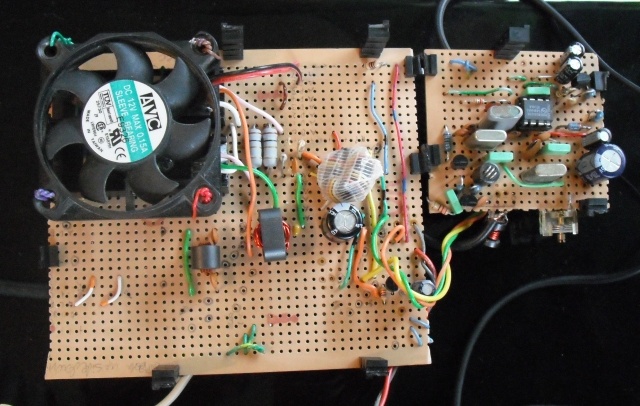
Well this is electronics old-school, making something from junk. This is how I started electronics; making things from stuff that would have otherwise been sent to the tip.
I saw this website http://www.robkalmeijer.nl/techniek/electronica/radiotechniek/hambladen/qst/2001/03/page37/index.html with a psk31 transceiver schematic on it. The kit the website talks about is no longer sold by the looks of things but looking at the components I figured I probably had enough bits and pieces to cobble together something that resembled the transmitter section of the schematic. I wondered if I had enough odds and ends that I could create the oscillator section without having to buy one single item. It turned out that I did indeed have enough components for the oscillator section and even had enough bits and pieces even to make the amplifier section too.
I started just by trying to create the oscillator section and would've been perfectly happy if that's all I could've done. The vero board was scavenged from some long defunct project and I just removed all the old components from it. The crystals are color burst frequency crystals which I had collected from old TV sets over the years, I had precisely three of them, one of them had started to acquire green rust type coating on top of it. the mixer ic ne602 I found in an old 1980s cordless phone. the inductor from an old CRT monitor, and so on; some of the components could be over 30 years old.
I didn't have any of 2n4401 transistors so instead I used 2n3904 which I found quite a few of them lying around the place. I also couldn't find a 7.5V zena diode so used a 6.8 V one instead.
The oscillator and filter worked surprisingly well so I started looking around to see how I could make the amplifier. After scavenging more vero board and bits and pieces the only tricky things left were the transformers and the amplifying transistors themselves. Needless to say I didn't have any 2sc2078 transistors lying around, instead I started searching through old CRT monitors and found something that could at least cope with the currents and voltages necessary the 2sd669a. The 2sd669a transistors I found in some sort of Transformers section of an old CRT monitor.
Finding ferrite for the Transformers was the most problematic thing I faced. I could find very few pieces of suitable ferrite. Ones that had vaguely the correct dimensions I had no idea what the material was. Along the way I made one-to-one windings and injected the input with the 3.579Mhz to compare the input signal with the output signal; Only the grey colored ferrite seem to not attenuate the signal too much. I found two binoculars shaped ferrites in the plugs that used to plug into the back of old TVs. However I needed three pieces, so the third piece I had to cut a long tube of ferrite used for shielding some electrical wire. ferrite is really difficult to cut it turns out, it's a ceramic so I managed to cut half way through it then it fractured the rest of the way.
And then I put the amplifier schematic into LTspice.

Inductor L9 I added later as it seemed to boost the signal strength somewhat at I suspect the cost of some linearity.
According to the simulator the output should be around the 3.5W to 4 W with a harmonic suppression data than 40 dB.


The little binoculars ferrite's make perfect transformers to wind. The binocular transformers feel much more secure than the toroid one that I had to make (this can be seen in the initial picture on this page; it's wrapped in sticky tape and looks like it's falling over).
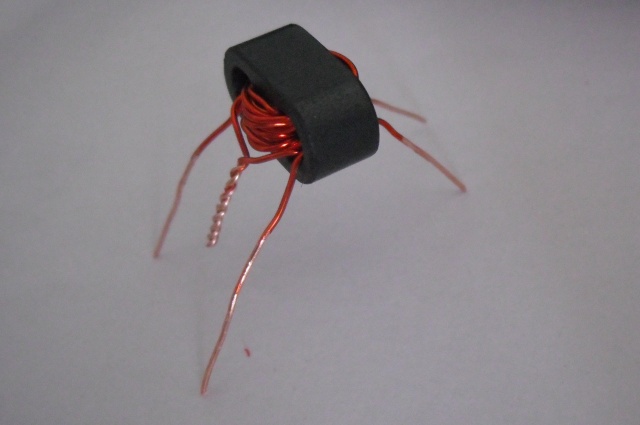
After connecting the amplifier up and putting a dummy load on the output I measured about 1W output. I must admit I was a little disappointed that it didn't match the simulation. After taking measurements at various locations of the board it seems that the 2sd669a transistors are not modeled properly in LT spice. I tried different models for the 2sd669a transistor each time giving somewhat different simulation results none of which matched reality. So hence this is a 1 W transmitter made out of junk not a 4 W transmitter made out of junk.
The next thing you might be asking is why a cooling fan when it only produces 1W of output. The reason is it's extremely inefficient. The two transistors only put out one watt of power but they seem to be dissipating another 3W of heat.
So the 2sd669a transistors don't exactly make a good substitute for the 2sc2078 but will function.
Testing
Being such a low frequency the antennas become much more tricky to make than ones in the VHF range; they become big and unwieldy.
Initially I just connected the output transmitter to a long wire through the trees. Designing antennas and matching them I am not good at.

On the receiving end I used a $10 dvb dongle connected to a ham-it-up up converter. I would not recommend this combination for receiving a HF signals. The ham-it-up up converter drifts, is really insensitive and tends to blow out the front-end of the dvb dongle making receiving anything extremely difficult. The dvb dongle also drifts. This however is the only way I can receive a HF signals these days.
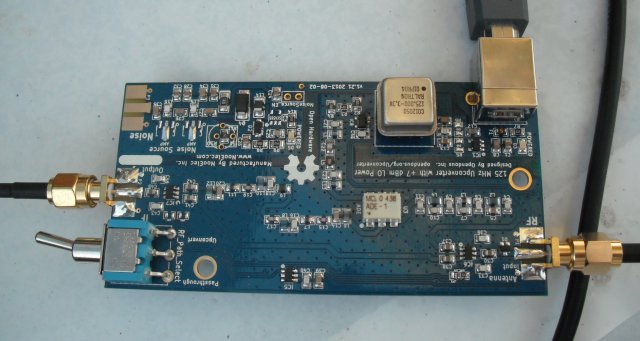
On the receiving end I just connected a few meters of wire to the ham-in-up as the antenna.
Looking at the signal and then the first harmonic which is the strongest harmonic I got the following screenshots.
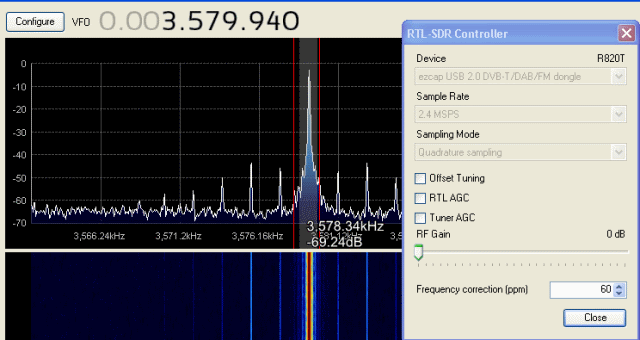
Main signal.
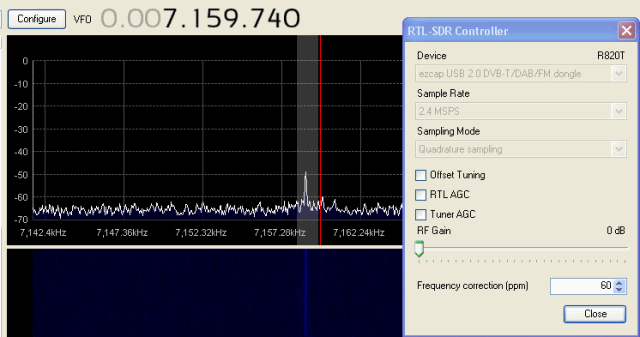
First harmonic.
Roughly about 40 dB less.
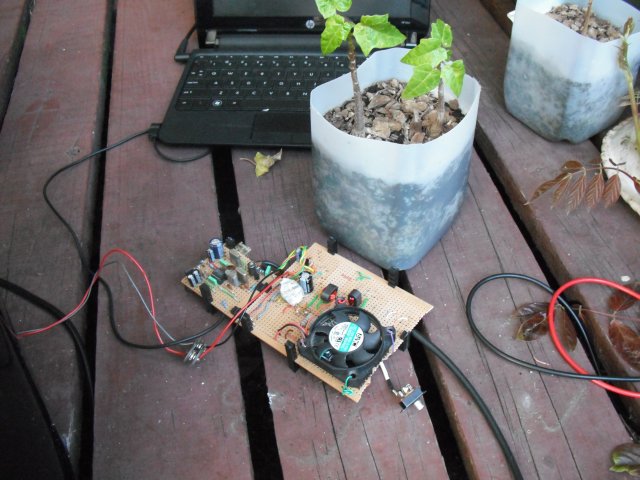
Transmitter waiting to be switched on.
At a distance of 1.06km with this setup I could just obtain a very weak signal that was just discernible on the waterfall display but one that I could not hear.
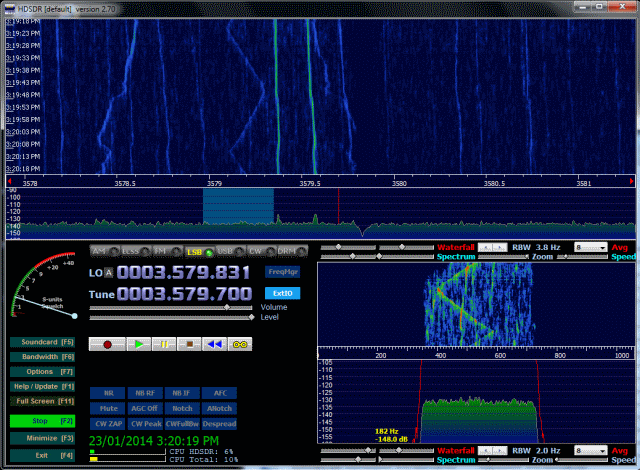
First test 1.06 km of very weak signal. (triangular waveform 100 Hz deviation)
So not exactly transmitting thousands of kilometers on milliwatts of power.
Testing 2
To improve the situation I attempted to create a better antenna for the ham-it-up and to match the transmitter to the other antenna.
The following picture shows the match between the ham-it-up and the small 2 or 3 meter antenna.
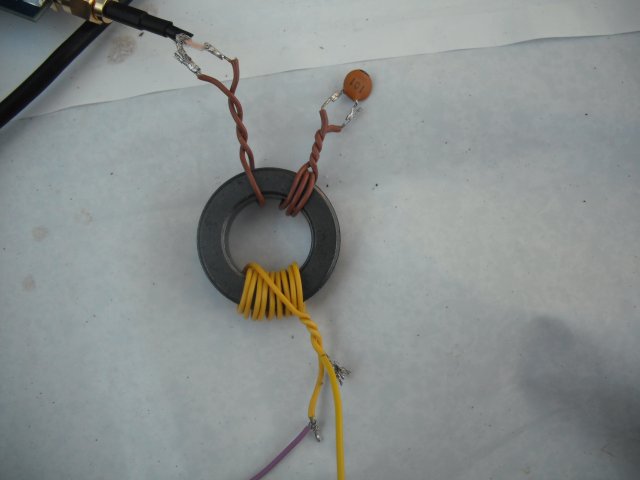
Match between ham-it-up and small 2 or 3 meter dipole antenna.
The idea of this was mainly to try to reduce all the other signals that ended up blowing out the front-end of the dvb dongle.
For the transmitted I tried an L impedance matching circuit. Below is a picture of this as well as a way of measuring the output voltage on the aerial side.
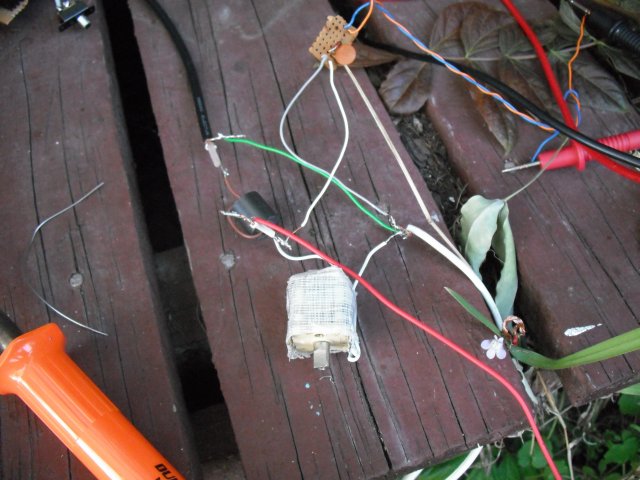
Only one wire went up in the air for the transmitter, the other one just draped along the ground.
At about the same location as the previous test with a distance of 1.29 km the signal came booming in as can be seen in the following picture.
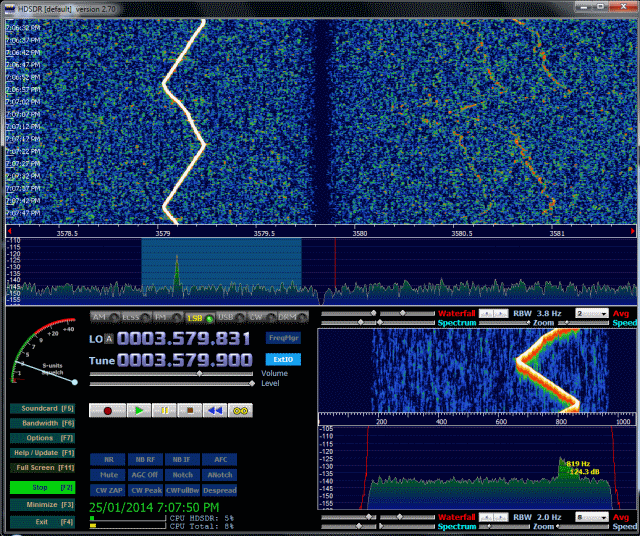
Second test 1.29 km, signal blooming in.
At 5.31 km the signal was still quite detectable.
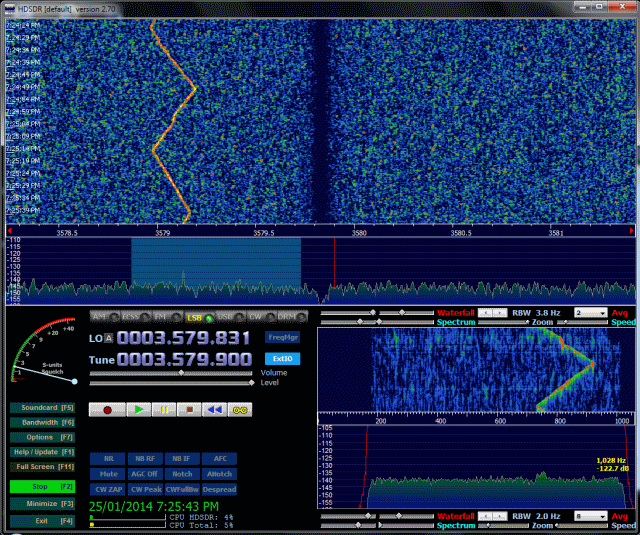
Second test 5.31 km, signal still audible.
At 7.67 km I reached a town and there were a lot of buildings and concrete. Due to this and the fact that I felt quite self-conscious about holding an aerial up in the air as cars drove past I did not stay there long to put myself in peculiar looking positions to maximize the signal. So the moment I saw the telltale triangular waveform I left. You can just see it in the following picture between about 750 and 950 Hz.
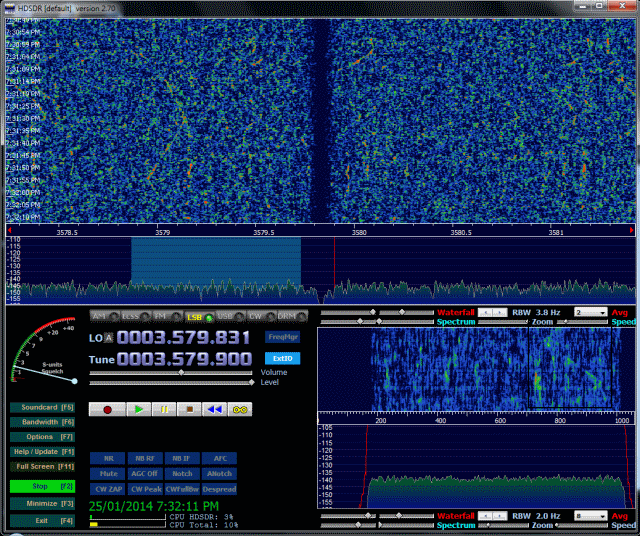
7.67 km is the furthest I've ever transmitted a signal, its a record.
All the frequency drift that you see in the screenshots is due to the ham-it-up and the dvb dongle.
So yup you can build a transmitter which is basically an SSB transmitter made out of little more than old TVs and old CRT computer monitors; so why not recycle some of the old electronics that gets thrown away and give it a new lease of life.
Jonti
2014